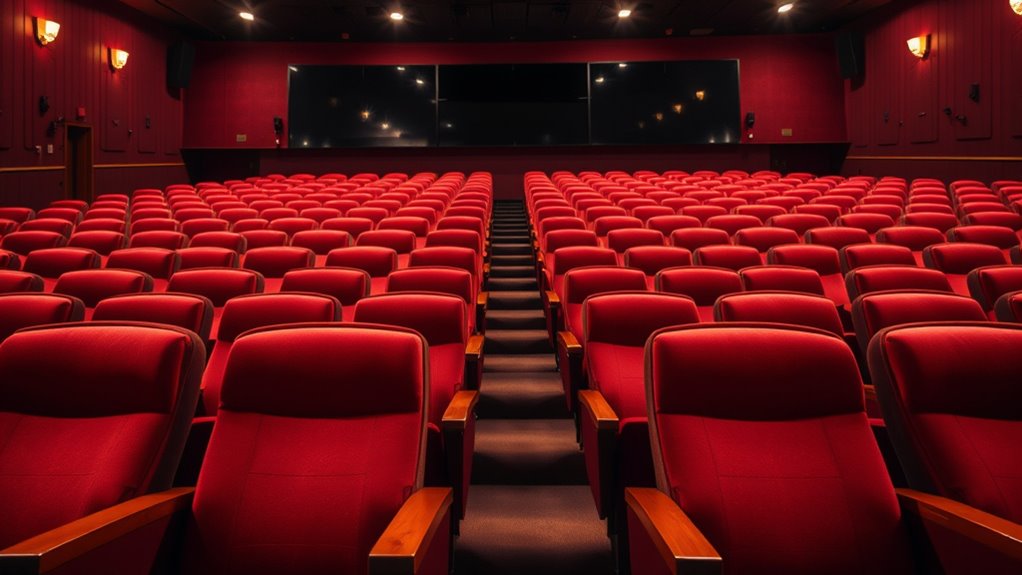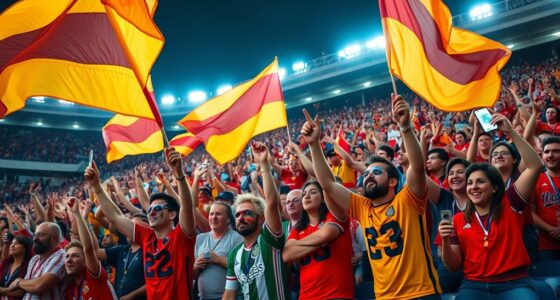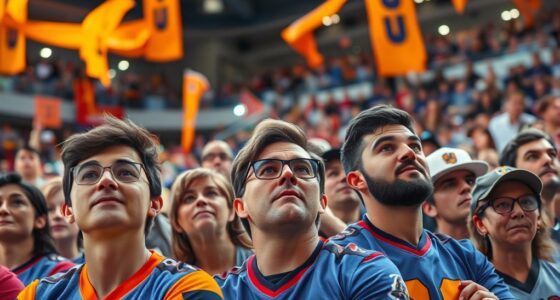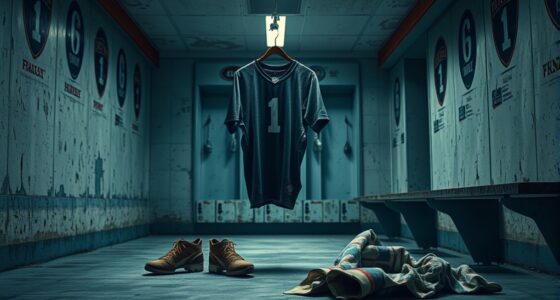Empty stadium seats on TV often give a false impression of low interest, but broadcasters and teams use camera angles, lighting, digital effects, and audio techniques to make the venue seem lively, regardless of actual attendance. They focus on action, enthusiastic fans elsewhere, and strategic visuals to hide empty spots. If you want to see how these tricks work and learn the truth behind the illusion, keep exploring the details.
Key Takeaways
- Camera angles and digital effects can make stadiums appear fuller, masking actual low attendance.
- Broadcast production techniques focus viewer attention on gameplay and fan reactions, reducing empty-seat visibility.
- Stadium acoustics and sound design can hide empty areas, creating a lively atmosphere regardless of attendance.
- Visual strategies, like crowd overlays and wide shots, maintain viewer engagement despite empty seats.
- Perceptions of event popularity are influenced more by broadcast presentation than actual ticket sales.
The Impact of Empty Seats on TV Viewership Perception
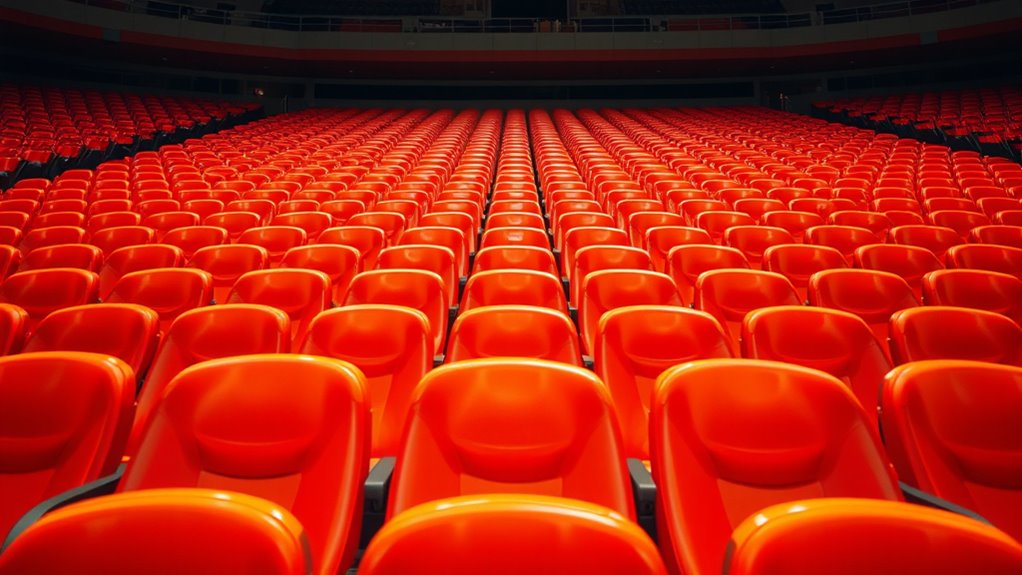
Empty seats on TV broadcasts often lead viewers to believe that a game or event is poorly attended, which can negatively affect their overall perception of the event’s popularity and excitement. This perception is rooted in fan psychology, where the visual cues of attendance influence how engaging the event appears. Broadcast aesthetics play a vital role here; the way cameras frame empty seats can amplify feelings of low interest or support. When viewers see large gaps in seating, they might assume a lack of enthusiasm, even if the event is well-attended in reality. This disconnect between actual attendance and broadcast visuals creates a skewed perception, making it seem like a less exciting event. Understanding this dynamic helps explain why empty seats impact viewership perception, regardless of the true crowd size. Additionally, the visual presentation of the event can significantly influence audience engagement and perceived excitement levels.
Why Stadium Attendance Does Not Equal Broadcast Quality
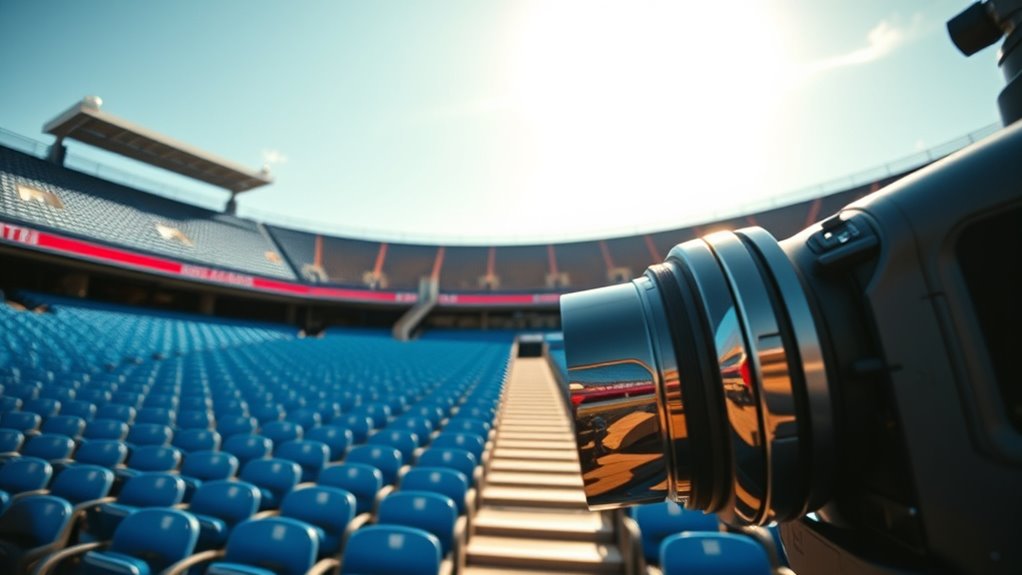
Stadium attendance levels don’t necessarily reflect broadcast quality because cameras and production choices can profoundly influence how an event looks on screen. Even with empty seats, skilled camera work can create the illusion of a packed stadium. Stadium acoustics also play a role; loud, well-mixed sound can mask emptier sections and enhance the overall experience for viewers. Ticket pricing affects attendance, but it doesn’t determine broadcast quality. High ticket prices may limit in-person crowds, yet broadcasters can still deliver vibrant, engaging visuals and audio that make the event seem lively and full. Remember, the quality of the broadcast depends more on production decisions than on how many people are physically present. A focused production can turn an empty stadium into an exciting televised event. Additionally, utilizing high-quality projectors and cameras can significantly improve the visual presentation, regardless of the actual attendance.
The Role of Camera Angles and Production Techniques
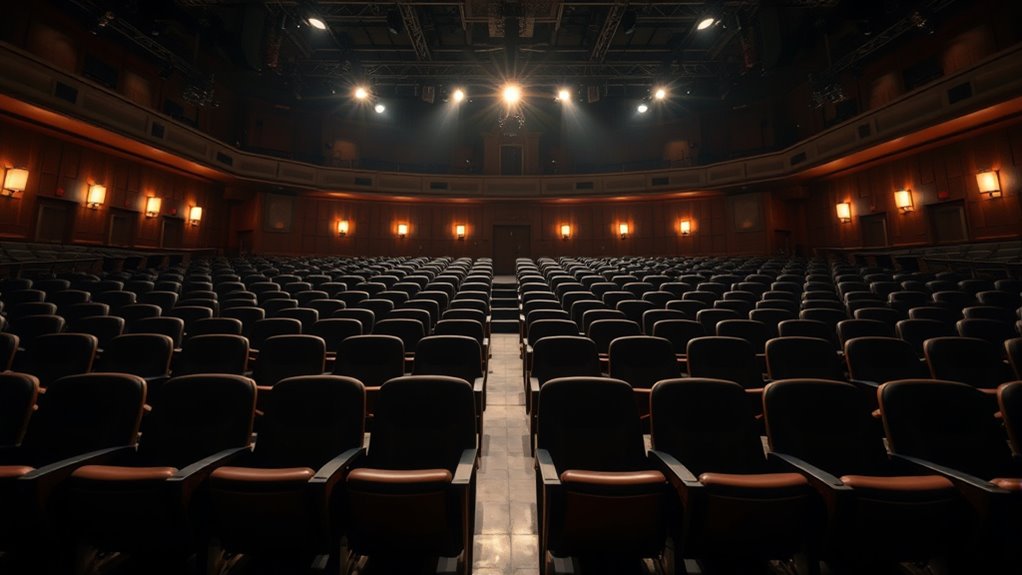
Camera angles and production techniques play a crucial role in shaping how a sporting event appears on television. Your experience relies heavily on camera framing and shot selection, which can emphasize or downplay empty seats. For example, broadcasters often choose wide shots that focus on the entire stadium, making empty areas less noticeable. Strategic camera angles can also highlight active gameplay, diverting attention from less populated sections. Skilled production teams carefully select shots to create a dynamic viewing experience, even when attendance is low. Additionally, the presence of mold or spoilage signs in lemon juice can be subtly concealed through camera angles and editing, ensuring the focus remains on the intended story. By controlling what viewers see and how it’s framed, they craft a perception that aligns with the broadcast’s narrative. This deliberate use of camera angles and shot choices ensures that the visual story remains engaging, regardless of stadium attendance.
The Influence of Sponsorship and Advertising Spaces
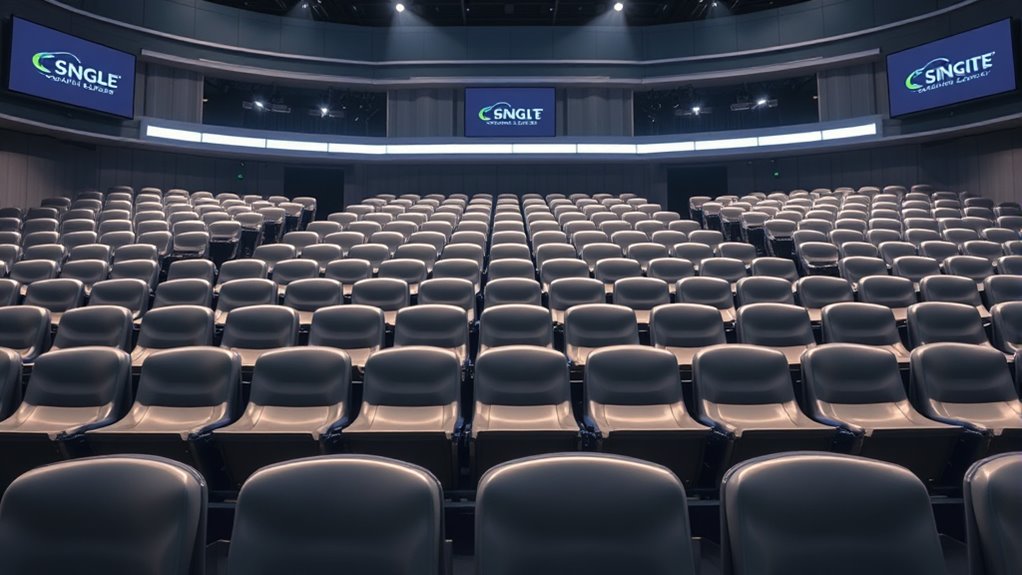
Have you ever noticed how sponsorship and advertising spaces are strategically placed to influence your perception of a game? These spots aren’t random; they’re carefully designed to maximize sponsorship visibility and reinforce advertising strategies. By positioning ads around the stadium and on-screen graphics, broadcasters shape what you see and remember. This deliberate placement often makes empty seats less noticeable or even irrelevant, as the focus shifts to the ads and sponsors.
Strategic ad placement around stadiums and screens shifts focus from empty seats to sponsors.
Additionally, placement strategies are employed to ensure that the audience’s attention remains on the advertising content, effectively overshadowing any distractions such as empty seats. These tactics help create a more dynamic viewing experience, regardless of seating arrangements.
Factors Behind the Appearance of Empty Seats on Screen
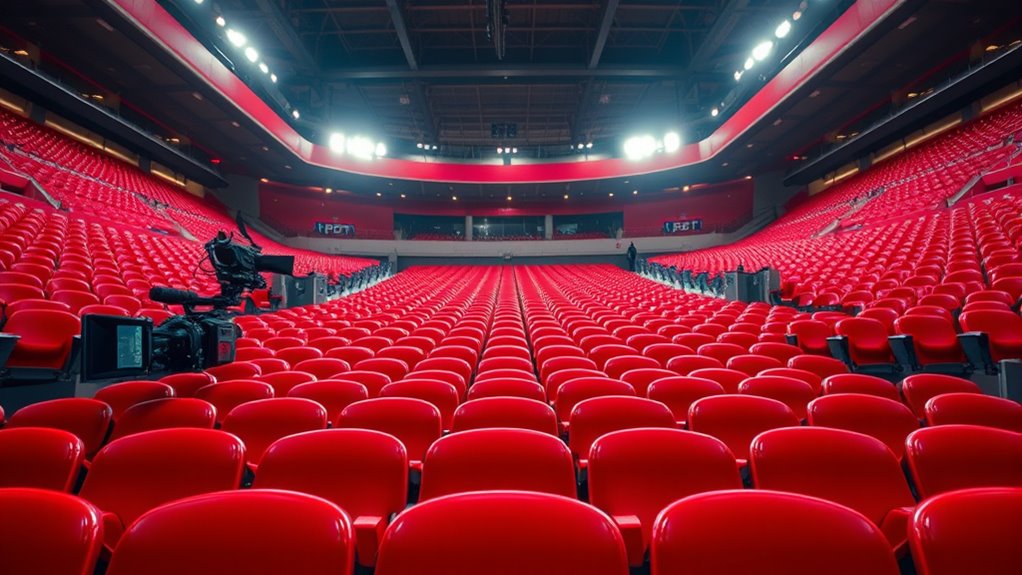
Several factors contribute to the appearance of empty seats on screen during broadcasts, often making the venue look less crowded than it actually is. Stadium acoustics play a role; loud crowd noise can mask empty seats, but camera angles and lighting highlight gaps, creating an illusion of emptiness. Additionally, event organizers sometimes prioritize merchandise sales by spacing out seating or leaving sections unfilled, which becomes visible on camera. Security and staff placements can also influence seat visibility, as they sometimes block parts of the stands. Camera focus and framing choices further exaggerate the emptiness, even if the arena is mostly full. Moreover, stadium design can impact how seats appear on television, as some venues have structural features that naturally cast shadows or create visual gaps. These elements combine to shape viewers’ perceptions, making the venue seem less packed despite high attendance.
The Myth of Empty Seats Reflecting Fan Engagement
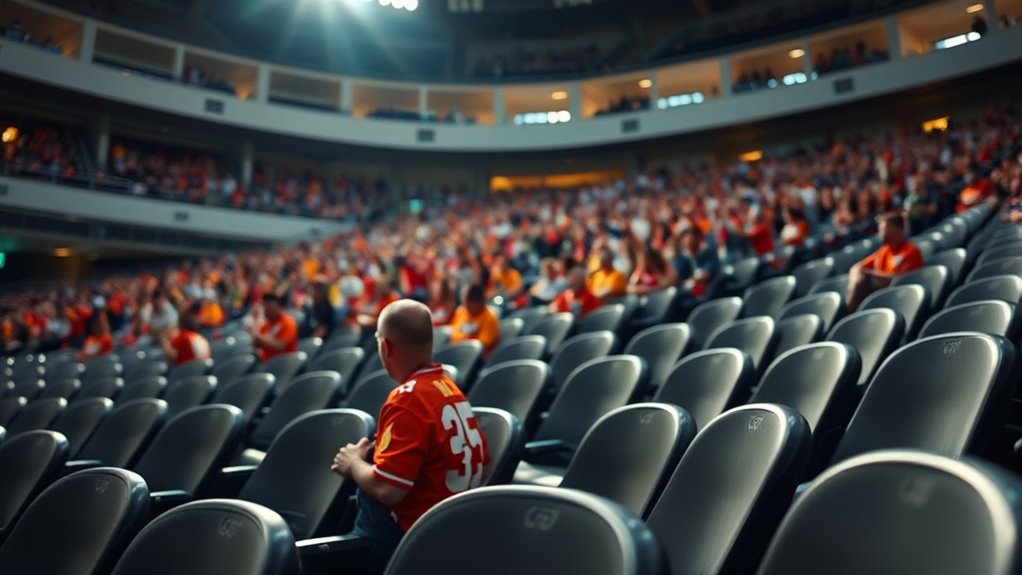
You might think empty seats mean fans aren’t engaged, but camera angles and focus can distort that impression. Different stadiums also see attendance fluctuate based on various factors, not just fan enthusiasm. So, what you see on TV doesn’t always tell the full story about how invested fans really are.
Camera Angles and Focus
Many assume that empty-looking sections in televised sporting events indicate low fan engagement, but this is often a misconception rooted in camera angles and focus choices. Broad shots can emphasize certain areas, making sections appear emptier than they really are. Focused camera work often highlights the most active or vibrant parts of the crowd, misleading viewers into thinking overall engagement is low. Additionally, broadcasters adjust camera angles based on ticket pricing zones and vantage points, not actual attendance. This can distort the perception of fan enthusiasm. Utilizing vertical strategies in camera placement can further skew perceptions by emphasizing specific sections over others, contributing to the illusion of low engagement.
- Strategic camera angles emphasize key sections, not attendance levels
- Focused shots highlight energetic fans, ignoring quieter areas
- Ticket pricing influences camera placement, skewing viewer perception of engagement
Stadium Attendance Variations
Camera angles and focus can distort how we perceive fan presence during a game, but they don’t tell the full story about attendance. Variations in stadium acoustics and the way sound travels can make sections seem emptier than they are, influencing perceptions. Additionally, concession sales often spike even when certain areas look sparse, indicating active fan engagement beyond what the camera captures. Teams strategically distribute fans and seat groups differently for security, sightlines, or comfort, which can create a false impression of low turnout. These factors mean that empty-looking seats don’t necessarily equate to disinterest or disengagement. Instead, they reflect logistical choices and environmental factors that influence how attendance appears on TV, not the true level of fan support or enthusiasm at the game. Understanding stadium acoustics is also key to recognizing how audio perception can impact our overall impression of crowd size.
How Broadcasters and Teams Address Empty-Seat Visuals
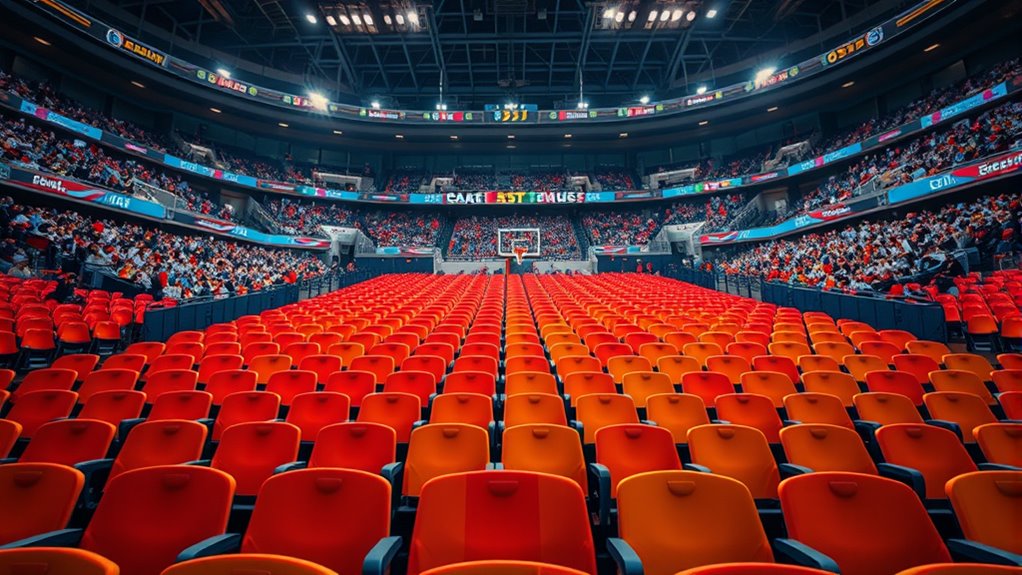
To make empty-seat visuals less distracting, broadcasters and teams strategically use camera angles, lighting, and digital effects to create a more engaging viewing experience. They focus on highlighting the action and fan enthusiasm elsewhere, minimizing the impact of low ticket sales. Techniques like wide shots, close-ups, and crowd overlays help craft a lively atmosphere even with empty sections. Digital effects, such as virtual crowds or augmented reality, fill in gaps and maintain visual energy. These strategies ensure viewers stay engaged without fixating on empty seats. By directing attention to passionate fans and dynamic gameplay, broadcasters counteract negative perceptions linked to low attendance, emphasizing the event’s excitement and spirit rather than ticket sales. Incorporating qualitative measures like fan engagement and atmosphere can further enhance the perception of success.
Frequently Asked Questions
Do Empty Seats Affect the Overall Broadcast Viewership Ratings?
Empty seats don’t substantially affect your overall broadcast viewership ratings, but they can impact audience engagement and advertising impact. When viewers see empty seats, they might perceive the event as less exciting, which could influence their enthusiasm and perception of the game or show. For advertisers, reduced engagement may lead to lower ad effectiveness. However, ratings are primarily driven by actual viewership numbers, not just optics.
How Do Different Camera Techniques Influence the Perception of Empty Seats?
Oh, the magic of camera angles and lighting strategies! You can make empty seats look bustling or deserted with just a tilt of the camera or a clever light setup. Wide shots might reveal the emptiness, but tight angles focus on players or commentators, hiding the gaps. Strategic lighting can cast shadows or highlight crowded areas, fooling viewers into thinking the arena’s packed when it’s actually far from it.
Are Empty Seats More Common in Certain Sports or Leagues?
You notice empty seats more often in certain sports or leagues due to stadium design and ticket pricing. Smaller venues or high prices can lead to lower attendance, especially for less popular games. Leagues with premium ticket costs tend to see more empty seats, while well-designed stadiums with flexible seating encourage fuller crowds. So, your experience reflects how these factors influence crowd size and the appearance of empty seats.
What Technological Advancements Help Minimize Empty Seat Visibility?
Empty seats can seem like a glaring neon sign, but advancements like color correction and strategic camera angles work magic to minimize their visibility. You’ll notice how color correction adjusts lighting inconsistencies, making empty seats less noticeable, while clever camera angles focus on enthusiastic fans and action, not empty rows. These technological innovations create a more vibrant, engaging broadcast, ensuring you’re immersed in the game without distractions.
How Do Teams and Broadcasters Address Fan Safety Concerns Related to Empty Seats?
You can see that teams and broadcasters prioritize fan safety by implementing clear guidelines to maintain stadium capacity limits. They actively promote fan engagement through safety messaging and social distancing protocols, helping fans feel secure. By managing stadium capacity carefully and communicating safety measures, they ensure everyone’s well-being while maintaining a lively atmosphere, making the experience enjoyable and safe for all attendees.
Conclusion
So, next time you see empty seats on your screen, remember it’s not the full story. Behind those shots, there’s a carefully crafted display, hiding the real energy and passion in the stadium. The truth is, what you see is just a glimpse—there’s much more happening beyond the camera’s eye. Stay curious, because the next time you watch a game, you might just see it differently… if you look a little deeper.
